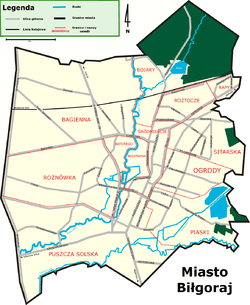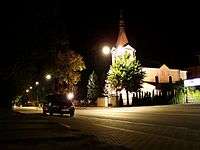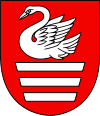Biłgoraj
| Biłgoraj | |||
|---|---|---|---|
|
Polish Baroque Church of the Assumption of Mary, early 17th century, Biłgoraj | |||
| |||
 | |||
 Biłgoraj | |||
| Coordinates: 50°33′N 22°44′E / 50.550°N 22.733°E | |||
| Country |
| ||
| Voivodeship | Lublin | ||
| County | Biłgoraj County | ||
| Gmina | Biłgoraj (urban gmina) | ||
| Established | 1578 | ||
| Town rights | 1578 | ||
| Government | |||
| • Mayor | Janusz Zbigniew Rosłan | ||
| Area | |||
| • Total | 20.85 km2 (8.05 sq mi) | ||
| Elevation | 212 m (696 ft) | ||
| Population (2014) | |||
| • Total | 27,106 | ||
| • Density | 1,300/km2 (3,400/sq mi) | ||
| Time zone | CET (UTC+1) | ||
| • Summer (DST) | CEST (UTC+2) | ||
| Postal code | 23-400 to 23-401 | ||
| Area code(s) | (+48) 84 | ||
| Car plates | LBL | ||
| Website | http://www.bilgoraj.pl | ||
Biłgoraj [bʲiwˈɡɔraj] (Yiddish: בילגאריי, Bilgoray, Ukrainian: Білґорай) is a town in south-eastern Poland with about 27,100 inhabitants (2014). Since 1999 it has been situated in Lublin Voivodeship; it was previously in Zamość Voivodeship (1975–1998). It is located south of Lublin and it is also the capital of Biłgoraj County. Historically, the town belongs to Lesser Poland, and is located in southeastern corner of the province, near the border with another historic land, Red Ruthenia. Biłgoraj is surrounded by forest, with three rivers flowing through it.
Location
The name of the town comes from a hill called Biely Goraj, on which Biłgoraj was founded in the 16th century. Biłgoraj lies in northern part of Sandomierz Basin, near Roztocze. The town is surrounded by Solska Wilderness, not far away (20 km (12 mi)) from Roztocze National Park. Administratively, since 1474 it has been tied with the city of Lublin. In that year, Lublin Voivodeship was split away from Sandomierz Voivodeship. An average July temperature in Biłgoraj is 18 °C (64 °F), an average January temperature −2.8 °C (27.0 °F). The town is crossed by four small rivers: Biala Lada, Czarna Lada, Osa and Próchnica. Biłgoraj lies on the elevations ranging from 190 to 205 meters above sea level. The area of the town is 20 square kilometres (8 square miles), of which forests covers 9%. Built-up area stretches along eastern bank of the Biala Lada, for 5 km (3 mi) (north - south) and 3 km (2 mi) (west - east).[1]
History
From the 16th century until 1918
The area of current Biłgoraj was covered by dense forests and swamps, where establishment of human settlements was difficult. In the first half of the 16th century, local noble family of Gorajski built first settlements in this sparsely populated corner of Lesser Poland. At that time, the villages of Gromada, Dabrowica and Olendrów were founded.
The town of Biłgoraj was officially established in 1570 by Adam Gorajski, and incorporated by King Stefan Batory at Lwow on September 10, 1578. Its main market square was placed on the hill called Bialy Goraj. The town, surrounded by rivers, held a strategic position and was easy to defend. Biłgoraj quickly grew, due to a busy merchant road from Jarosław to Lublin. Biłgoraj town was surrounded by a defensive wall with watchtowers, although the town’s further growth extended into suburbs. A bridge was built over the Biala Lada. Until 1693 Biłgoraj remained in the hands of the Gorajski family. Throughout the 18th century, it belonged either to the Szczuka family or the Potocki family. Most houses in Biłgoraj were made of wood, which resulted in several fires. Furthermore, the wars of the mid-17th century destroyed the town twice; first in 1648, when the town was burned by the Cossacks of Bohdan Khmelnytsky; then in 1655, by the Swedes during the deluge.
Biłgoraj was an important center of the Bar Confederation, and in the area of the town several skirmishes took place between the Poles and the Russians. After the Partition of Poland, Biłgoraj was annexed by the Austrian Empire, and in 1809 it became part of Duchy of Warsaw (since 1815, Russian-controlled Congress Kingdom). In the late 18th century its population was 3,000; and grew to 6,000 by 1865. At that time, it was the third biggest town of Lublin Governorate, after Lublin and Hrubieszow.[1]
In 1806 following the Partitions, Biłgoraj – which was still privately owned and on the verge of bankruptcy – was purchased by the local entrepreneur named Stanisław Nowakowski,[2] who built for himself a palace in Biłgoraj's district of Roznowka, modelled after Warsaw’s famous Lazienki Palace. The town remained in the hands of the Nowakowski family until 1850, when it was sold to the Tsarist official Nikolay Platonov (Mikołaj Płatonow), and in 1864 appropriated by the government as the seat of a county. During the January Uprising, several skirmishes took place Biłgoraj and its vicinity.
After 1918
In 1918 Biłgoraj returned to newly created Second Polish Republic. Its population in 1921 reached 5,600. In 1928, electrification reached the town, but Biłgoraj nevertheless remained poor and underdeveloped, where most houses were constructed of wood. On September 11, a unit of German-minority Fifth column agents set fire to the town, which destroyed most of it. Furthermore, the Luftwaffe bombed Biłgoraj twice (Sept. 8, and Sept. 14). On September 15–16, 1939 units of Krakow Army and Lublin Army retreating towards Tomaszow Lubelski, fought the Wehrmacht in the Battle of Biłgoraj. The Germans tried to capture the towns several times, but they did not manage to do so until September 17, after yet another fire. On September 28, units of the Red Army entered Biłgoraj, but they retreated after a few weeks, and the town became part of the Nazi-ruled General Government.
During the German occupation, Biłgoraj was an important center of the resistance. Local units of the Home Army and other clandestine organizations took part in the Zamosc Uprising. Germans knew well that Solska Wilderness was filled with Polish fighters, and the Poles frequently attacked German units in Biłgoraj. The most famous incident of this kind took place on September 24, 1943, when a Home Army unit under Tadeusz Sztumberk-Rychter attacked Biłgoraj's prison, releasing 72 inmates, including Ludwik Ehrlich. Historically, the town was a center of a large Jewish community, whose population in 1931 reached 4,596.[3] Most of Biłgoraj's Jews perished in the Holocaust. The Germans left Biłgoraj on July 24, 1944. During the war, 80% of the town was destroyed, and it lost 50% of its population. After 1945 Biłgoraj was rebuilt, becoming by 1975 the most important industrial center of Zamosc Voivodeship.
Districts
Biłgoraj is divided into twelve districts:
- I. Śródmieście
- 1. Dist. Przemysłowa
- II. Nadstawna
- III. Roztocze
- 2. Dist. Łąkowa I
- 3. Dist. Łąkowa II
- IV. Bojary
- 4. Dist. Bojary
- V. Rapy
- VI. Sitarska – Kępy
- 5. Dist. Sitarska I
- 6. Dist. Sitarska II
- 7. Dist. Sportowa
- 8. Dist. Kępy
- VII. Ogrody
- VIII. Piaski
- 9. Dist. Prusa
- 10. Dist. Leśnik
- IX. Puszcza Solska
- 11. Dist. Sienkiewicza
- 12. Dist. Krzeszowska
- 13. Dist. Południe
- X. Rożnówka
- 14. Dist. Wioska Dziecięca
- XI. Bagienna
- 15. Dist. Bagienna
- XII. Batorego
Historic places and interesting buildings


- Stanisław Nowakowski's Park - an old park in the town affectionately nicknamed Małpi Gaj (English: Monkey Marsh). It is a last relic of a Nowakowski's palace. The park was designed as a garden in the 17th century. The original gate to the town still stands there. The old garden keeper's cottage also survives to this day. The same cannot be said about the small villa which stood deep in the park, but now has been completely vandalised.
- Polish Baroque Church of the Assumption of Mary from early 17th century. The building is located on Trzeciego Maja Stret, next to Plac Wolności (Market Square).
- Church of the St. George on Tadeusz Kościuszko Street, not very large building from XIXth century, former Eastern Orthodox church.
- Mary Magdalene church in Puszcza Solska district. Built on the beginning of 1920s, surrounded by monumental objects of franciscan monastery, small bell tower and Mary Magdalene Chapel (all from XVIIth century).
- Zagroda Sitarska Museum - open-air museum on Nadstawna Street, built in the beginning of XIXth century. The main building is wooden home, with exhibition of traditional making sieves industry. All objects of museum are surrounded by neighbouring multi-family buildings.
Local folklore
Biłgoraj is an important center of local folklore, with highly developed folk art, regional clothes and customs. This is due to the town’s location, among forests, where communication with other communities was limited. There are several “Biłgoraj-style” houses, and in the area numerous wayside shrines can be found. Biłgoraj's folklore was used by Grzegorz Ciechowski in his songs written as Grzegorz z Ciechowa. Until the 19th century, famous green Biłgoraj beer was produced in the town. Furthermore, for centuries Biłgoraj was a major national center of sieve makers. The town has a Regional Museum and an Open-air museum Zagroda Sitarska. Due to its proximity to Roztocze National Park, it is visited by a number of tourists. It also has a Baroque church of Holy Trinity (17th century) and 12 different monuments.
Transport
Biłgoraj is located away from main Polish roads. It is a junction of two local arteries - Road nr. 835 (north - south, from Lublin to Przemyśl), and Road nr. 858 (east - west, from Zamość to Nisko). Nearest national road Nr. 74 (Zamosc - Stalowa Wola) goes 17 kilometres (11 miles) north of the town. Biłgoraj has a rail station on a secondary - importance line from Zamość to Stalowa Wola, through the town also goes the Broad Gauge Metallurgy Line. Nearest airport, Rzeszow-Jasionka Airport, is located 110 km (68 mi) to the south.
Industry
In Biłgoraj are located a headquarter and main factories of Black Red White, leading furniture manufacturer in Poland. The town is also known as a center of wine industry (Ambra company bottling plants are located in village Wola Duża, 4 kilometres (2 miles) east of the city), knitting (mainly thanks to Mewa factory) and production of cardborads packages, wooden doors and windows.
Twin towns
Biłgoraj is twinned with:
|
|
Notable people from Biłgoraj
- Isaac Bashevis Singer – winner of the Nobel Prize in Literature lived in Biłgoraj when he was young. His mother was born in Biłgoraj. The town and villages surrounding the area are featured in many of his stories and novels.
- Konrad Bartoszewski – writer, commander of a partisan unit during World War II
- Justyna Bąk – 3000 meters steeplechase world champion
- Shmuel Ben-Artzi – Israeli writer, poet and educator, and the father in-law of the Israeli prime minister Benjamin Netanyahu
- Katarzyna Lewandowska – solo singer of the Great Theatre, Warsaw
- Joanna Kaczor – athlete
- Marzena Karpińska – weightlifter
- Harry Keitel – father of actor Harvey Keitel
- Stefan Knapp – painter
- Janusz Palikot – member of parliament
- Roman Tokarczyk – lawyer, philosopher
- Kazimierz Węgrzyn – international soccer player
- Mordechai Rokeach – known as Mordechai of Bilgoray, Rav of Biłgoraj before World War II
- Shmuel Atzmon – Wircer creator of Yiddishpiel Theatre in Israel
References
- 1 2 "Local history". Biłgoraj. Virtual Shtetl. pp. 1 of 2. Retrieved May 4, 2012.
- ↑ "Dzieje Biłgoraja (History of Biłgoraj). Ustrój i gospodarka finansowa". Strona miasta. Retrieved May 4, 2012.
- ↑ JewishGen.org
External links
| Wikimedia Commons has media related to Biłgoraj. |
Coordinates: 50°33′N 22°42′E / 50.550°N 22.700°E



